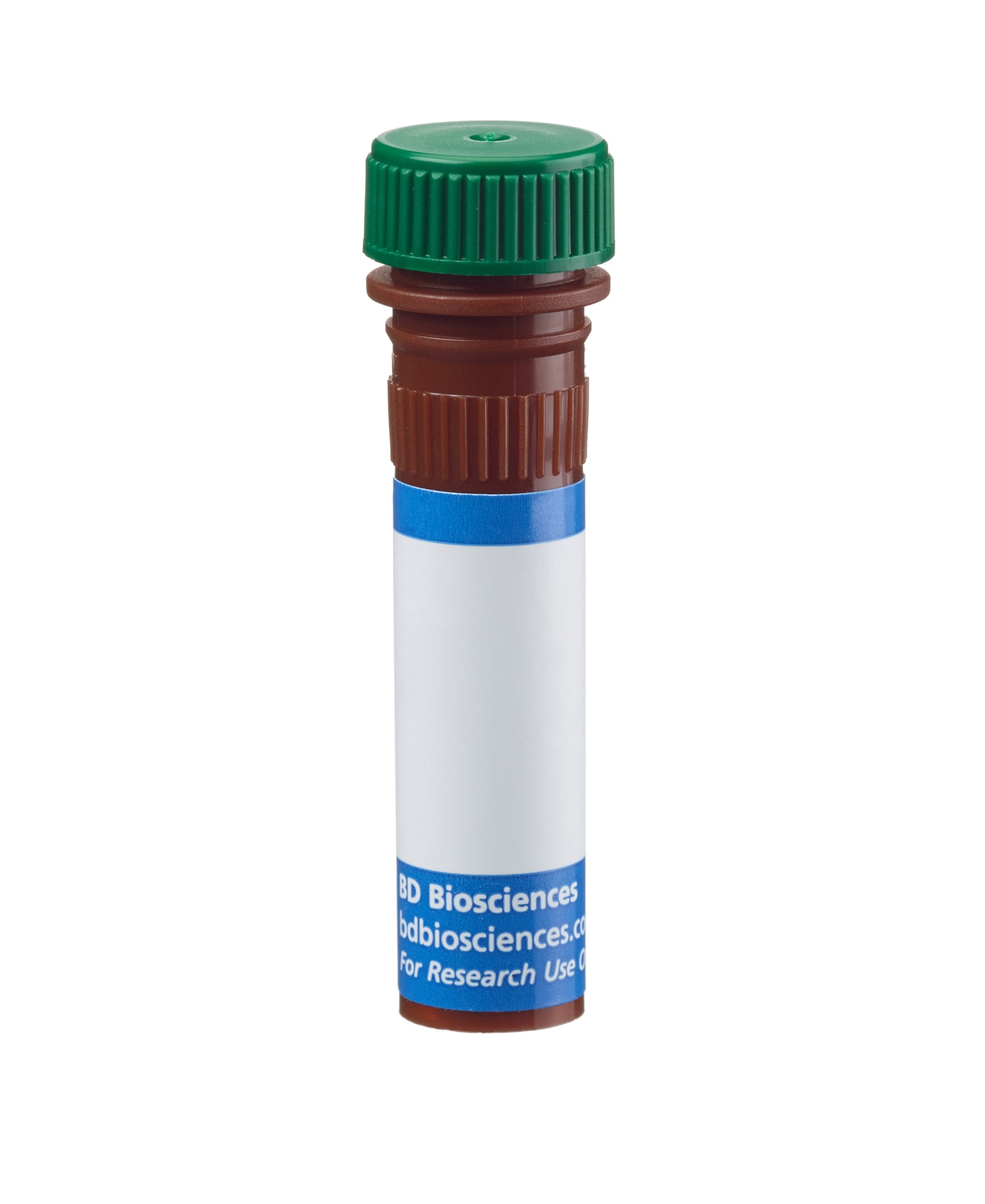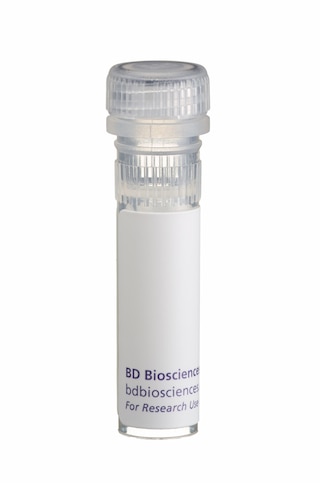Old Browser
This page has been recently translated and is available in French now.
Looks like you're visiting us from {countryName}.
Would you like to stay on the current country site or be switched to your country?




Multiparameter flow cytometric analysis of CD215 (IL15Rα) expression on human monocytes. Human peripheral blood mononuclear cells were cultured in complete tissue culture medium without (Left Plots) or with (Right Plots) lipopolysaccharide (LPS, 100 ng/ml) and Recombinant Human IFN-γ protein (Cat. No. 554617, 10 ng/ml) for 20 hours at 37°C. The cells were harvested, preincubated with Human BD Fc Block™ (Cat. No. 564219), and then stained with APC Mouse Anti-Human CD14 antibofy (Cat. No. 555399) and with either BD Horizon™ BB515 Mouse IgG2b, κ Isotype Control (Cat. No. 564510; Upper Plots) or BD Horizon™ BB515 Mouse Anti-Human CD215 (IL15Rα) antibody (Cat. No. 567746/567747; Lower Plots). BD Via-Probe™ Cell Viability 7-AAD Solution (Cat. No. 555815/555816) was added to cells right before analysis. Bivariate pseudocolor density plots showing the correlated expression of CD215 (IL15Rα) [or Ig Isotype control staining] versus CD14 were derived from gated events with the forward and side light-scatter characteristics of viable (7-AAD negative ) monocytes. Flow cytometry and data analysis were performed using a BD LSRFortessa™ X-20 Cell Analyzer System and FlowJo™ software.


BD Horizon™ BB515 Mouse Anti-Human CD215 (IL-15Rα)

Regulatory Status Legend
Any use of products other than the permitted use without the express written authorization of Becton, Dickinson and Company is strictly prohibited.
Preparation And Storage
Recommended Assay Procedures
BD® CompBeads can be used as surrogates to assess fluorescence spillover (Compensation). When fluorochrome conjugated antibodies are bound to CompBeads, they have spectral properties very similar to cells. However, for some fluorochromes there can be small differences in spectral emissions compared to cells, resulting in spillover values that differ when compared to biological controls. It is strongly recommended that when using a reagent for the first time, users compare the spillover on cells and CompBead to ensure that BD® CompBeads are appropriate for your specific cellular application.
For optimal and reproducible results, BD Horizon Brilliant™ Stain Buffer should be used anytime BD Horizon Brilliant™ dyes are used in a multicolor flow cytometry panel. Fluorescent dye interactions may cause staining artifacts which may affect data interpretation. The BD Horizon Brilliant Stain Buffer was designed to minimize these interactions. When BD Horizon Brilliant Stain Buffer is used in in the multicolor panel, it should also be used in the corresponding compensation controls for all dyes to achieve the most accurate compensation. For the most accurate compensation, compensation controls created with either cells or beads should be exposed to BD Horizon Brilliant Stain Buffer for the same length of time as the corresponding multicolor panel. More information can be found in the Technical Data Sheet of the BD Horizon Brilliant Stain Buffer (Cat. No. 563794/566349) or the BD Horizon Brilliant Stain Buffer Plus (Cat. No. 566385).
For optimal results, it is recommended to perform 2 washes after staining with antibodies. Cells may be prepared, stained with antibodies and washed twice with wash buffer per established protocols for immunofluorescence staining, prior to acquisition on a flow cytometer. Performing fewer than the recommended wash steps may lead to increased spread of the negative population.
Product Notices
- Please refer to www.bdbiosciences.com/us/s/resources for technical protocols.
- Caution: Sodium azide yields highly toxic hydrazoic acid under acidic conditions. Dilute azide compounds in running water before discarding to avoid accumulation of potentially explosive deposits in plumbing.
- This reagent has been pre-diluted for use at the recommended Volume per Test. We typically use 1 × 10^6 cells in a 100-µl experimental sample (a test).
- For fluorochrome spectra and suitable instrument settings, please refer to our Multicolor Flow Cytometry web page at www.bdbiosciences.com/colors.
- An isotype control should be used at the same concentration as the antibody of interest.
- BD Horizon Brilliant Stain Buffer is covered by one or more of the following US patents: 8,110,673; 8,158,444; 8,575,303; 8,354,239.
- Please refer to http://regdocs.bd.com to access safety data sheets (SDS).
- Alexa Fluor™ is a trademark of Life Technologies Corporation.
Companion Products






The JM7A4 monoclonal antibody specifically binds to CD215, which is also known as the IL-15 Receptor alpha subunit (IL-15R-alpha, IL-15Ra, or IL-15Rα). This type I transmembrane glycoprotein is encoded by IL15RA (Interleukin 15 receptor subunit alpha) and is variably expressed on macrophages, natural killer (NK) cells, T cells and B cells and by some nonlymphoid cells including fibroblasts. Although it can independently bind IL-15 with high affinity, it does not contain a signaling motif. CD215 (IL-15Rα) can present IL-15 in cis or trans fashion to the IL-2/15R beta (CD122) and IL-2R gamma (γc or CD132) receptor complex which can then transduce signals intracellularly. Several different CD215 (IL-15Rα) isoforms have been described that are produced by alternative splicing and may alter signal transduction responses to IL-15. A cleaved soluble form of CD215 known as sIL-15RA has also been reported which can bind and antagonize IL-15 activity. By binding to its heterotrimeric receptor, IL-15 plays crucial roles in innate immunity, eg, through the activation of NK cells and adaptive immunity, eg, in enhancing the survival of CD8+ memory T cells.
The antibody was conjugated to BD Horizon™ BB515 which is part of the BD Horizon Brilliant™ Blue family of dyes. With an Ex Max near 490 nm and an Em Max near 515 nm, BD Horizon BB515 can be excited by the blue laser (488 nm) laser and detected with a 530/30 nm filter. This dye has been exclusively developed by BD Biosciences and is up to seven times brighter than FITC with less spillover into the PE channel. Due to similar excitation and emission properties, BB515, FITC, and Alexa FluorTM 488 cannot be used simultaneously. It is not recommended to use BB515 in cocktails that include Streptavidin conjugates as it may cause high background.

Development References (5)
-
Dubois S, Mariner J, Waldmann TA, Tagaya Y. IL-15Ralpha recycles and presents IL-15 In trans to neighboring cells.. Immunity. 2002; 17(5):537-47. (Immunogen: Flow cytometry). View Reference
-
Llinas L, Lazaro A, de Salort J, Matesanz-Isabel J, Sintes J, Engel P. Expression profiles of novel cell surface molecules on B-cell subsets and plasma cells as analyzed by flow cytometry. Immunol Lett. 2011; 134(2):113-121. (Clone-specific: Flow cytometry, Immunohistochemistry). View Reference
-
Matesanz-Isabel J, Sintes J, Llinas L, de Salort J, Lazaro A, Engel P. New B-cell CD molecules. Immunol Lett. 2011; 134(2):104-112. (Clone-specific: Flow cytometry). View Reference
-
Mortier E, Bernard J, Plet A, Jacques Y. Natural, proteolytic release of a soluble form of human IL-15 receptor alpha-chain that behaves as a specific, high affinity IL-15 antagonist.. J Immunol. 2004; 173(3):1681-8. (Biology). View Reference
-
Vámosi G, Bodnár A, Vereb G, et al. IL-2 and IL-15 receptor alpha-subunits are coexpressed in a supramolecular receptor cluster in lipid rafts of T cells.. Proc Natl Acad Sci USA. 2004; 101(30):11082-7. (Clone-specific: Immunofluorescence). View Reference
Please refer to Support Documents for Quality Certificates
Global - Refer to manufacturer's instructions for use and related User Manuals and Technical data sheets before using this products as described
Comparisons, where applicable, are made against older BD Technology, manual methods or are general performance claims. Comparisons are not made against non-BD technologies, unless otherwise noted.
For Research Use Only. Not for use in diagnostic or therapeutic procedures.
Report a Site Issue
This form is intended to help us improve our website experience. For other support, please visit our Contact Us page.